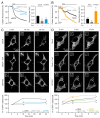Role of the c subunit of the FO ATP synthase in mitochondrial permeability transition
- PMID: 23343770
- PMCID: PMC3594268
- DOI: 10.4161/cc.23599
Role of the c subunit of the FO ATP synthase in mitochondrial permeability transition
Abstract
The term "mitochondrial permeability transition" (MPT) refers to an abrupt increase in the permeability of the inner mitochondrial membrane to low molecular weight solutes. Due to osmotic forces, MPT is paralleled by a massive influx of water into the mitochondrial matrix, eventually leading to the structural collapse of the organelle. Thus, MPT can initiate mitochondrial outer membrane permeabilization (MOMP), promoting the activation of the apoptotic caspase cascade as well as of caspase-independent cell death mechanisms. MPT appears to be mediated by the opening of the so-called "permeability transition pore complex" (PTPC), a poorly characterized and versatile supramolecular entity assembled at the junctions between the inner and outer mitochondrial membranes. In spite of considerable experimental efforts, the precise molecular composition of the PTPC remains obscure and only one of its constituents, cyclophilin D (CYPD), has been ascribed with a crucial role in the regulation of cell death. Conversely, the results of genetic experiments indicate that other major components of the PTPC, such as voltage-dependent anion channel (VDAC) and adenine nucleotide translocase (ANT), are dispensable for MPT-driven MOMP. Here, we demonstrate that the c subunit of the FO ATP synthase is required for MPT, mitochondrial fragmentation and cell death as induced by cytosolic calcium overload and oxidative stress in both glycolytic and respiratory cell models. Our results strongly suggest that, similar to CYPD, the c subunit of the FO ATP synthase constitutes a critical component of the PTPC.
Keywords: ATP5G1; apoptosis; caspases; cytochrome c; mitochondrial respiratory chain; p53; permeability transition pore (PTP).
Figures



References
-
- Kroemer G, Galluzzi L, Vandenabeele P, Abrams J, Alnemri ES, Baehrecke EH, et al. Nomenclature Committee on Cell Death 2009 Classification of cell death: recommendations of the Nomenclature Committee on Cell Death 2009. Cell Death Differ. 2009;16:3–11. doi: 10.1038/cdd.2008.150. - DOI - PMC - PubMed
Publication types
MeSH terms
Substances
Grants and funding
LinkOut - more resources
Full Text Sources
Other Literature Sources
Molecular Biology Databases
Research Materials
Miscellaneous
